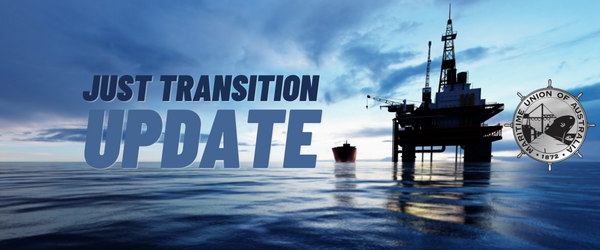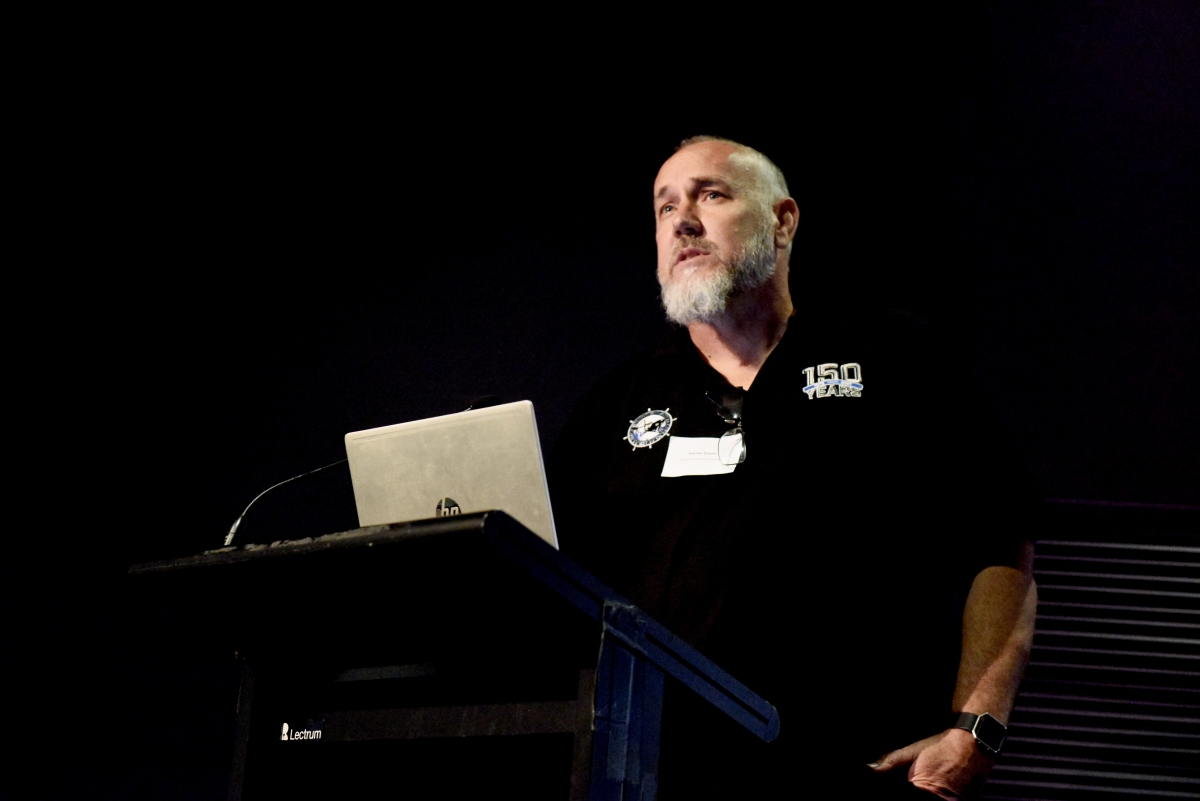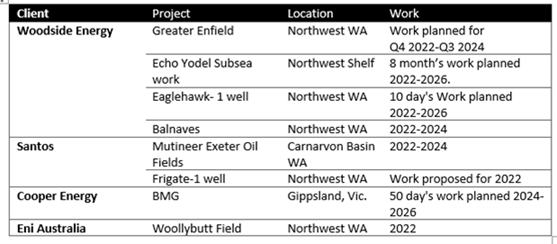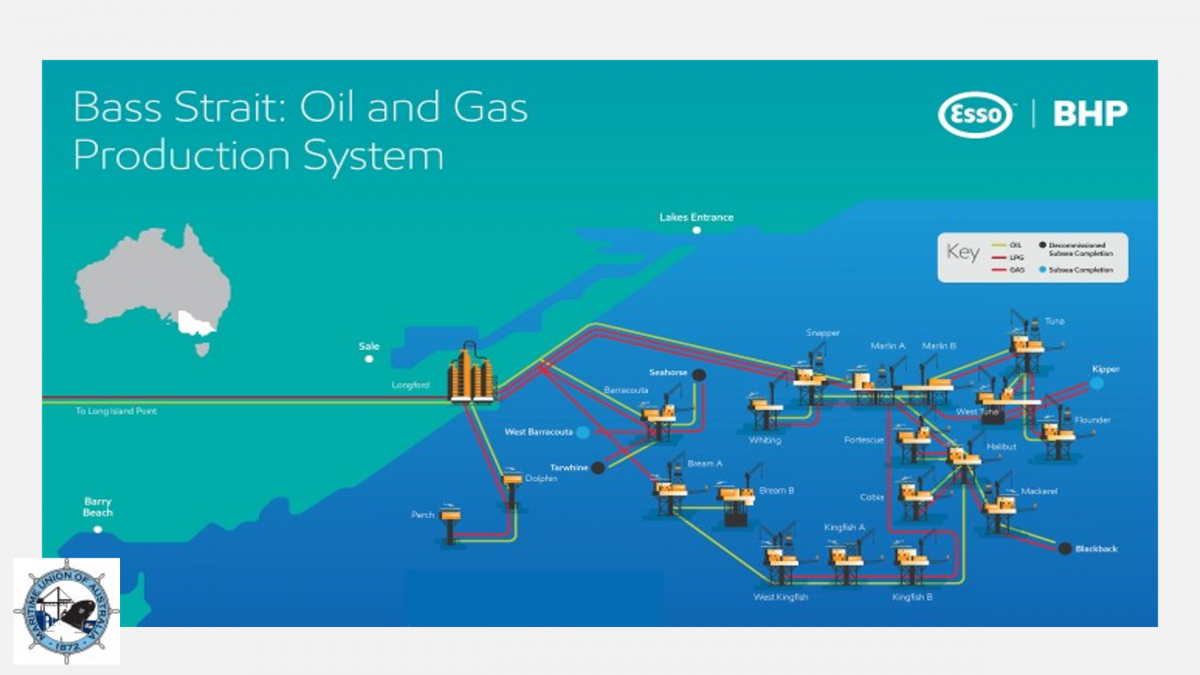Published: 9 Dec 2022

The MUA will regularly update the MUA website and continue to send newsletters regarding Just Transition employment opportunities that are in the works for our membership. Please make sure you read through this update on offshore oil and gas decommissioning and discuss it at your onboard meetings.

The offshore oil and gas industry will continue for much longer that some expect but there is no doubt the sun is setting on the industry as the world moves to combat climate change. Credit to the foresight of former WA Branch Assistant Secretary Danny Cain who identified this before many acknowledged it and he set us on a course of establishing offshore renewables industry to ensure the future of our seafaring members is secure for generations to come.
Decommissioning will play just as important a role in the “Just Transition” for maritime workers as the hydrocarbon industry dies down and we turn to renewable energy opportunities like offshore wind. The National Energy Resources Australia (NERA) and the Centre of Decommissioning Australia (CODA) commissioned a report in 2021 that identified the cost of decommissioning disused offshore assets off our coast is over $52 Billion Dollars and that half of this work needs to commence in the next 10 years.
The Northern Endeavour debacle has emphasised decommissioning as an big challenge for Australia and legislation on trailing liabilities and an industry levy were put in place late 2021 to ensure taxpayers would not be left footing the bill for the massive decommissioning task ahead.
Most offshore assets in Australia are 30+ years old, and over half are due for decommissioning in the next decade. We have 11 floating facilities, over 1000 wells, 57 fixed facilities, 82 pipelines, and thousands of tonnes of subsea infrastructure ready to be decommissioned and removed off our coast.
The decommissioning industry is dominated by steel (3560 kilotons) followed by concrete structures (1390 kilotons), but the pipelines and subsea equipment do the actual damage. Much of this equipment contains naturally occurring radioactive materials, or 'NORMS' known to be toxic to marine life and the broader environment. Unfortunately, pipelines are the most consistent structure that offshore operators are requesting to abandon, and it is our job to ensure they don't get away with it.
89% of the total mass requiring removal is located off WA across three key basins (Northern Carnarvon, Browse, and Bonaparte), followed by Gippsland, Victoria, with 9%.
WA accounts for 92% of the pipeline disposal mass and 100% of the floating facilities.
At this point, the only released information regarding decommissioning work is for projects between 2022-2024. We only know this because publicly visible lodged environment plans are available on the regulator's website.
The industry is dragging its feet to begin this work partly because of the considerable time frame NOPSEMA has given to decommission these projects and as a cost-saving method to further their research that supports leaving as much equipment in place as possible.
We can gauge what is to come by directions issued by NOPSEMA and environmental plans submitted for approval, but that doesn't capture all the work. At this point, NOPSEMA has refused to share all expected projects with us.

Bigger projects will be complete in stages, and work will increase as these are approved by NOPSEMA.
Three key pieces of legislation come into play during the decommissioning process of Australia's offshore oil and gas facilities.
Laws currently require the complete removal of oil and gas property but offer operators an option to deviate from the legislation if they can prove that doing so provides a better environmental outcome. This onus of proof lies on industry to back up their requests with evidence, and unsurprisingly millions of dollars to support their position are now in the works.
As well as this, we believe the permit-to-dump system needs a complete overhaul. The costs for industry to abandon mammoth structures are next to nothing; this must be corrected.
We're also currently dealing with NOPSEMA, who are trying to streamline the decommissioning application process by taking over responsibilities to oversee both the OPGGS and EPBC Acts. This 'streamlining process' is an absolute rort and allows NOPSEMA to approve massive decommissioning projects without any other government department involvement. Where is the independency of each piece of legislation?
The more decommissioning work approved, the more jobs for our members! We need robust laws ready to handle the decommissioning industry, and we will continue to fight to get these laws right!
Another huge issue we've come across has been Esso's Gippsland decommissioning campaign. This infrastructure sits smack bang in the middle of the renewable energy zone proposed for 2025, but NOPSEMA has given Esso until 2027 to clean up after themselves. We have argued this issue in our submission to NOPSEMA that requests Esso must remove all infrastructure. It is imperative that we make way for offshore wind projects, as this work is the future for our members.
To see the proposed offshore wind map click here.
Experts in the oil and gas field have explained that leaving wellheads in place provides easy access to re-plug leaking wells, but presently, there is no monitoring system. We have seen a recent update in trailing liability provisions that hold operators responsible for these structures, but how do we know if they are leaking? With over 1000 wellheads currently sitting off Australia's coast, these structures must be monitored regularly, and we see this as an excellent opportunity to secure work in this area.
At no point has the MUA been deemed relevant to speak to by any of the oil and gas operators when submitting their decommissioning proposals to NOPSEMA, often arguing risk to workers safety as a reason to dump their disused assets at sea rather than remove them – even though our members are doing the work! The MUA deserves consultation during the decommissioning process, and we want full transparency of all work to come, approved decisions, and permit applications. As a start, the MUA has requested to become a 'relevant person' for the Esso project. We will report back on this outcome.
Each time NOPSEMA approves infrastructure to remain at sea, it sets a precedence for future companies to do the same. It is up to us to continue to hold NOPSEMA to account. This pressure will be an ongoing issue for the MUA and members will be called upon to play an active role in the campaign.
With 5,700 kilotons of equipment degrading in our oceans, estimates show that 120 kilotons of waste must be removed every year., yet we are facing some big issues to ensure that the work remains local.
There are 27 facilities available in Australia that can deal with dismantling, 38 that can deal with processing the materials, and 23 that have recycling capabilities. At this point, Australia is nowhere near capable of dealing with the mass tonnage of degrading equipment that decommissioning work will create.
A shift to focus on local disposal yards will only happen if we can ensure facilities can accept offshore structures, which means we must ensure government investment and decent policy aimed at stimulating the market and improving these facilities.
But we do have one thing on our side. The Basal convention has been implemented into Australia’s Hazardous Waste (Regulation of Exports and Imports) Act 1989. This is an international treaty that Australia is now bound by that restricts the exploitation of hazardous wastes to poorer countries. The permit application system is lengthy and maritime lawyers expect it will be impossible to obtain.
This graph shows the expected disposal requirement of materials. Peaks of decommissioning are expected between 2025-2030.

In July of this year, Esso produced its first decommissioning campaign document to the public, asking for feedback. The paper has proposed to chop off eight of the ten steel pile jackets at 55 meters and dump the cut materials onto the seabed adjacent to the remaining structures. Under the current regulations, there is no requirement for Esso to ask for public feedback, so it was vital that the MUA, along with other unions, jumped on this opportunity.
Due to the MUA’s strong understanding of issues with Esso’s decommissioning campaign, we took on the responsibility of creating a template submission and circulated this through the ACTU and environment groups. This template was utilised by the ACTU, ETU, AMWU and AWU and ensured a unified response to Esso’s environmental plan from the broader union movement regarding decommissioning and removing all oil and gas infrastructure.
Please see attached a copy of the MUA’s submission to NOPSEMA. The submission argues:

One month later, the new government began the consultation process on the first offshore renewable energy area located where Esso's current decommissioning campaign is due to commence. The CFMMEU (MUA and Construction Divisions) and the ETU made a joint submission on 7 October, calling for all disused infrastructure to be removed by 2025 so that it does not interfere with construction of the renewable energy zone. This submission also argues:
In late November, the government of Western Australia released their draft discussion paper which sets out the Department of Mines, Industry, Regulation and Safety approach and expectations with respect to decommissioning onshore and State waters.
The MUA and CFMEU construction division WA branches made a submission to DMIRS which you can read here.
The MUA will be meeting with government to further discuss these issues in late December and will report back to the membership the outcome of this submission when it is available.
This last six months has had a heavy research focus as well as spending time speaking with comrades and experts across the field to ensure we are on top of every aspect of this massive decommissioning task ahead. We need to make sure we get this Just Transition plan right so we maximise the work opportunities for our members right across our union, our seafarers, our towage workers, our wharfies, our port workers and our divers.
We have incorporated the decommissioning work into the claims for the 2022 Offshore EA by ensuring that all decommissioning work is paid at the 117% rate.
We have engaged with Environment Minister Tanya Plibersek, Resource Minister Madeline King and Fremantle MP Josh Wilson to highlight the issues that have risen so far. We will continue to have these conversations to ensure the best outcome of MUA decommissioning jobs and just transition opportunities for our members.
We have also begun to kick off this campaign publicly, with our first rally held at the NOPSEMA offices in Melbourne. Our goal is to remind the regulator we will continue to keep it accountable for the decisions made. This is the first of many more rallies to come.

Our intention in this offshore bargaining round is that you will still be working under the normal Offshore EA, swing lengths and manning levels will depend on the agreement you are covered by and we are pursuing the vessel operators and manning agents through the current EA to have decommissioning projects on a pay rate of 117%.
This will depend on the materials being recovered. Wellheads can be brought up in a matter of weeks, pipelines can take months. There has been no modelling done on how many jobs will be created from decommissioning yet. What we do know, is there is going to be enough decommissioning and offshore renewables work to support all of our seafaring members!
Decommissioning plays just as important a role in the Just Transition for maritime workers as the hydrocarbon industry dies down and we turn to renewable energy opportunities like offshore wind.
It’s time to start ramping up this campaign, and we plan for more member engagement and educating the public as we fight to secure our demands for this new industry.
If you have any questions about decommissioning feel free to contact our Decommissioning Policy Analyst, Emma Cain on emma.cain@mua.org.au
We want to see NOPSEMA come down harder on these companies. They make profits off the backs of our hard work, and they must be made responsible to clean up after themselves!!
The MUA will continue to lead the way on fighting for a decommissioning industry that supports our membership!